
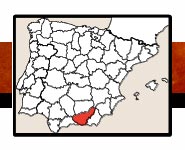

 |
 |
||
 |
|||
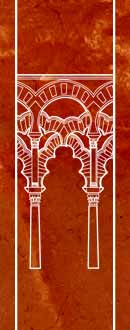 |
(40)/D-J/GRAN-Grana1-40.jpg) |
-55/BOOK-cort-40.jpg) |
 |
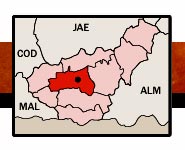 |
||
 |
|||
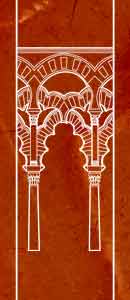 |
EL MEXUARConstruido por Ismail I, es el lugar donde se reunían los visires o ministros, en consejo o sura; el espacio central esta soportado por 4 columnas, el resto ha sido muy alterado en tiempos de Carlos V y Felipe IV. EL PALACIO DE COMARESEn origen debió de ser un bonito palacio decorado con vidrieras (“cumarias” – comares), hoy no conservadas, el gran patio central dispone de un gran estanque, en un extremo se ubica la torre de Comares, al que se accede desde el patio por la sala de la barca (de la bendición o “baraka”), en los extremos hay alcobas; también hay que mencionar al Baño de Comares. |
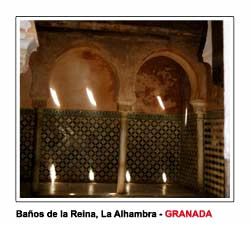 |
THE MEXUARBuilt by Ismail I, is is the place where the viziers or ministers met, in council (sura); the central space is supported by 4 columns, the rest was very altered in times of Carlos V and Felipe IV. THE PALACE OF COMARESIn the past was a beautiful palace decorated with stained-glass windows (“cumarias” – comares), today not preserved, The large central courtyard has a big pool, at one end is located the tower of Comares, which is accessed from the courtyard by the room of La barca (boat in english, but “barca” is similar to “baraka” = blessing in arab), at the ends there are bedrooms; also it is necesary to mention the Bath of Comares. |
 |
PATIO DE LOS LEONESEs la zona privada del complejo, el harén del sultán, es obra de Muhammad V, es el palacio más espectacular de la Alhambra, esta rodeado de una galería de finas columnas, de mármol de Macael, dos templetes presiden los extremos del patio, también de mármol de Macael son los leones y la taza de la fuente conocida como “Fuente de los leones”, en los laterales tenemos algunas de las salas más bellas del arte nazarí con cúpulas de una riqueza ornamental única en el arte de todos los tiempos, son las salas de los Mocárabes, de los Reyes, de los Abencerrajes y de las Dos Hermanas. Todo creado con unas pequeñas piezas prismáticas, los mocárabes, que crean juegos geométricos de gran complejidad. |
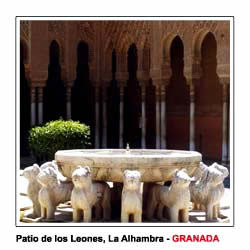 |
THE COURTYARD OF THE LIONSIt is the private area of the complex, the sultan's harem, is a work of Muhammad V, is the most spectacular palace of La Alhambra, is surrounded by a gallery of fine columns, of Macael marble, two temples at the ends of the courtyard, also of Macael is the marble of the lions and the fountain cup known as “Fountain of the lions”, on the sides its possible admire some of the most beautiful halls of Nasrid art, with domes with a ornamental beauty unique in the art of all times, are the rooms of Los Mocárabes, Los Reyes, Los Abencerrajes and the room of Las 2 hermanas (Two sisters). All created with a little prismatic pieces, called “mocárabes” that produce geometric games of incredible complexity. |
 |
EL GENERALIFE Y EL PARTALEs quizás el palacio más antiguo de época de Muhammad II, con restauración en el siglo XIV, el palacio disponía de 2 patios, con bonitos jardines. El Partal fue construido a comienzos del siglo XI en tiempos de Muhammad III, destacando el pórtico de 5 arcos y una torre hacia el norte. EL PALACIO DE CARLOS VEs de planta cuadrada, diseñado por Pedro Machuca, es un edificio renacentista con elementos manieristas, sobresaliendo el almohadillado de la fachada y el clasicismo del patio circular. |
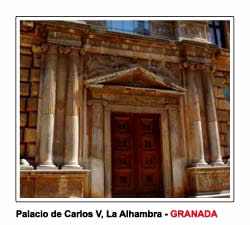 |
THE GENERALIFE AND THE PARTALGeneralife is perhaps the oldest palace of Muhammad II with restoration in the 14th century, the palace has 2 courtyards, with beautiful gardens. The Partal was built at the beginning of the 11th century in the time of Muhammad III, emphasizing the portico of 5 arches and a tower towards the north.PALACE OF CARLOS VIt is a square palace, designed by Pedro Machuca, it is a Renaissance building with Manierist elements, standing out the cushioning of the façade and the classicism of the circular courtyard. |
 |
HORARIOS-ENTRADAHorario de verano (15 de marzo a 14 de octubre), de lunes a domingo de 8:30-14:00 y de 14:00-20:00. El horario de invierno (15 de octubre a 14 de marzo), de lunes a domingo de 8:30-14:00 y de 14:00-18:00. La entrada general son 14€, con muchas entradas reducidas. UBICACIÓNEn Granada por la autopista, coger la carretera de Motril (A-44) y en la salida 132, veras el cartel. Se ubica en el casco antiguo de Granada y hay suficiente cartelería. ACCESO PARA MINUSVÁLIDOSAccesible parcialmente con silla de ruedas. |
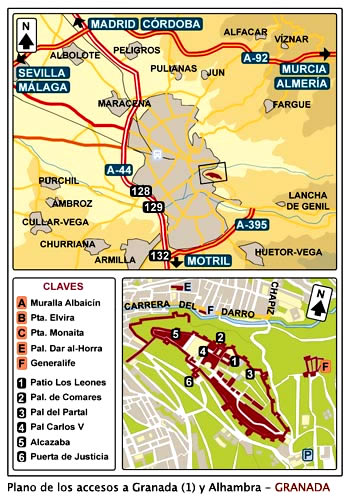 |
TICKETS AND TIMETABLEThe Summer timetable (Mach 15th – October 14th), Monday to Sunday is from 8,30 to 2 and from 2 to 8. The winter timetable (October 15 th to March 14 th ) is Monday to Sunday from 8,30 am to 2 pm and 2 pm to 6. General rate is € 14, with many reduced tickets. LOCATIONIn the access to Granada by the motorway, take the Motril road (A-44), and in the exit 132, you'll see the signpost. It is located in the old center of Granada, there are signpostes. ACCESS FOR THE HANDICAPPEDPartially accessible for wheelchairs. |
||||
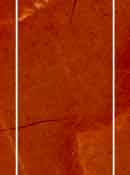 |
|||||||